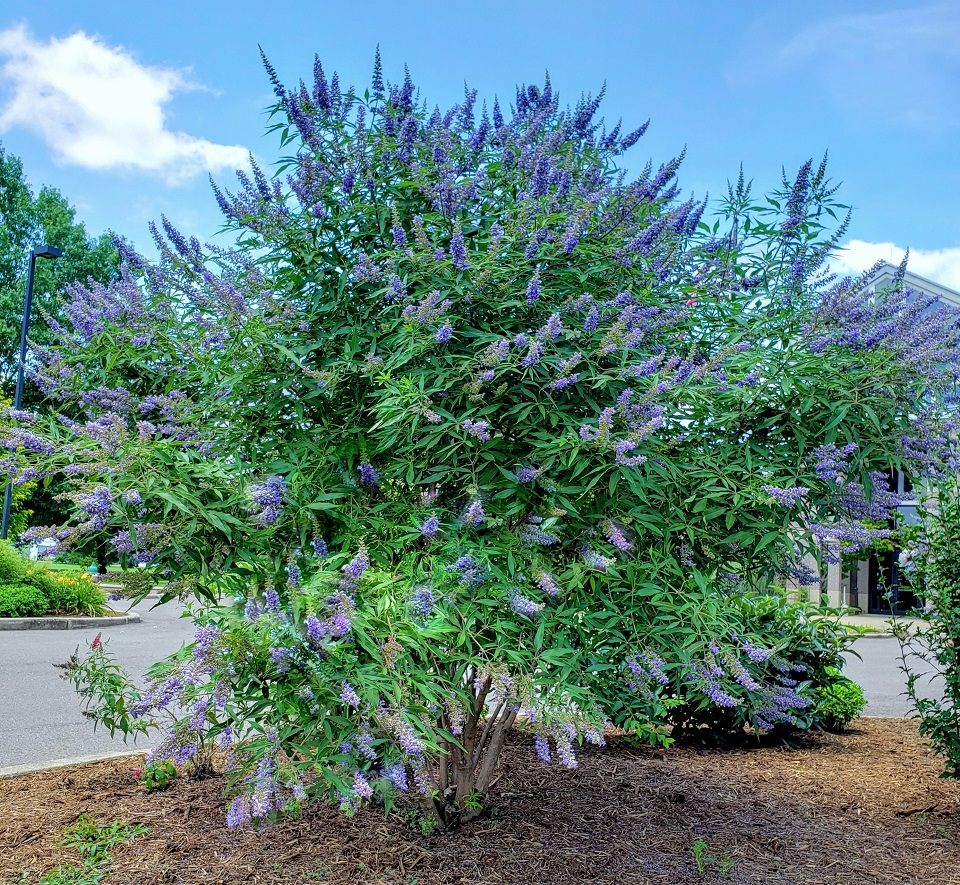
UT Gardens’ July 2019 Plant of the Month: Chastetree
Submitted by Carol Reese, UT Extension Western Region horticulturist, and Richard Gibson, assistant horticulturist, UT Gardens, Jackson
Ancient chastetrees, also called Vitex agnus-castus, can be found at old homes across the South, a testimonial to its durability. A couple of decades ago old homesteads were about the only place you might run across them, as they were considered passé and were no longer carried in garden centers.
Fortunately chastetrees have gone through a revival in popularity, and many forms are currently available in the trade. A variety of growth habits, from small trees to rounded shrubs, will suit many landscapes. Terminal bloom panicles are usually in shades of blue, purple or lilac, but white- and pink-blooming forms can also be found.
Although its other attributes are plenty, the bloom time for this plant has been extended later in the year in some of the newer cultivars, making chastetree an even more garden-worthy plant. It is also extremely drought tolerant once established and has no pests or disease issues.
Another endearing quality of this plant is the back story. Chastetree earned its name because it was said to be an herb given to monks to suppress their sex drive and thus help to keep them chaste. It was also strewn into the beds of women whose husbands were away in war to help cool their lust.
The plant’s Latin name acknowledges the story, with ‘agnus’ being derived from the Greek word ‘hagnos’ meaning pure or virginal, and the Latin word ‘castus’ meaning chaste and moral.
If you peruse herbal products sold in drugstores that are intended to help women with a variety of hormone-based disorders, you will find chastetree listed as an ingredient, and in a small number of reputable double-blind studies, it has been shown to have some efficacy. This does not confirm the plant’s storied reputation for suppressing the libido, but it does hint that there is some effect on human hormone levels.
Plant this deciduous shrub in full sun and well-drained soil. Larger cultivars can be limbed up to form small trees, and dwarf cultivars make rounded shrubs that range from 3 feet to several feet tall. When needed, chastetree size can be controlled by pruning back as it will bloom on new growth. This is an asset that allows it to be used as a cutback shrub in regions of Tennessee where it is marginally hardy. Even in warmer parts of Tennessee, there may be dieback during years of severe winter, but regrowth from roots can be expected from well-established plants.
Some fairly common cultivars include:
Blue Puffball™ (First Editions®), deep blue blooms, 3- to 4-feet tall and wide
Delta Blues™ (First Editions®), purple blooms, 10 feet tall
Blue Diddley® (Proven Winners®), purple blooms, 7 feet tall
‘Shoal Creek’, purple bloom,15 feet tall with 12-inch inflorescences
Gardeners in colder parts of Tennessee may wish to try a different species of chastetree, Vitex negundo, which is hardier by several degrees.
The UT Gardens includes plant collections located in Knoxville, Jackson and Crossville. Designated as the official botanical garden for the State of Tennessee, the collections are part of the University of Tennessee Institute of Agriculture. The Gardens’ mission is to foster appreciation, education and stewardship of plants through garden displays, educational programs and research trials. The Gardens are open during all seasons and free to the public. For more information, see the Gardens website: ag.tennessee.edu/utg.